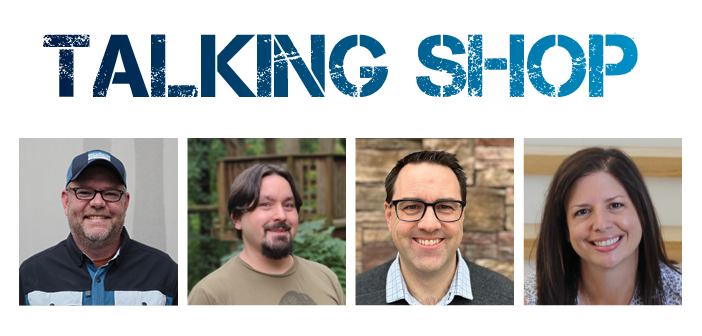While adventure parks have continued to enjoy growth, unfettered for the most part by competition within the industry, many remain constrained by ongoing issues with staffing and weather, among other things, according to a roundtable of top operators convened by API in December.
The discussion brought together Steve Carne, owner and chief experience officer at Maryland-based Terrapin Adventures; Candie Fisher, president of Outdoor Ventures; Carson Rivers, vice president of Challenge Towers; Lee Kerfoot, owner of Minnesota-based Kerfoot Canopy Tour and Brainerd Zipline Tour; and API editor Dave Meeker to talk about the current state of the industry.
Growth, Mostly
Fisher said that Outdoor Ventures “saw business continue to grow” overall across its half-dozen locations, despite challenges.
“Our Maui location is not operating anymore because of the fires in Lahaina,” she noted, and the company’s Northeast locations were hampered by a long stretch of lousy weekend weather over the summer.
“When the weather was good, we had really strong numbers,” said Fisher. “It really depended on location and the weather this year.”
For Terrapin, “double-digit growth” in summer 2023, “has been in ancillary things to the adventure park itself,” said Carne. “What we do adventure park-wise is pretty stable, but there seems to be more demand for things like caving, backpacking, summer camps, and other products around our adventure park.”
Weather woes. Weather played a role in dampening early-season visitation for Challenge Towers’ High Gravity Adventures in Boone, N.C., when unseasonably cool temperatures seemed to keep folks away.
“We had a slow start in May and the first half of June, and I got scared, thinking ‘it’s all falling apart,’” said Rivers. “But as we got into the meat of the summer, it was strong, and we have continued to have good business into the fall.”
The unpredictable weather, largely attributed to climate change, proved to be both a curse and a blessing to High Gravity Adventures.
“It was a little cooler, and nobody wanted to come up to the mountains yet,” Rivers said. “And then, in the summer when the heat really kicked in, everybody wanted to come, so we picked that ground back up.”
The ups-and-downs came on the heels of a few unpredictable seasons, Rivers said, with 2020 down and 2021 “through the roof. It was 30 percent better than any other year we’ve ever had,” he said. “But then it kind of fell back. We’ve had slight growth over pre-pandemic, but just sort of steady, normal growth.”
The Staffing Situation
There’s only so much adventure park operators can do about the weather or a global pandemic, of course, but addressing staffing and emerging consumer trends can at least help mitigate the challenges posed by elements like rain and heat.
“In our summer months, when we had great staffing, we were up double digits,” said Kerfoot, “but we lost that entire ground in September and October due to staffing. Our prices were fine, but we ended up just 4 or 5 percent up in total riders. That was a bummer.”
Kerfoot added that the park “may go to a more aggressive pricing [model]if we don’t have the staff” to maximize profits at times of the year when staffing limits capacity. “We turn a ton of people away.” His operations have only been able to get enough staff in one out of the last four years during the fall.
For Carne, having a 12-month operation and a diverse product and activity mix to keep things interesting—”the fact that they’re not just doing the same thing every day, day in and day out”—helps Terrapin retain workers.
“I have positions that are year-round; there’s not a lot of jobs in the winter and down season, but it makes a significant impact on being able to keep enough core staff around,” he said. “For fall programs, a lot of college students are in school, but we find a way to make it work.”
Fisher said that Outdoor Ventures enjoyed particularly strong staff retention this year— “probably the best ever in terms of people coming back from last season,” she said.
Professional development; cash incentives. “I hope part of that is that we have been investing in a more formal professional development program, making sure our managers are having regular conversations with staff about not just how they’re doing at the park, but what their long-term goals are, what we can help them with,” she said.
“We’ve also put in place a learning management system with quick video content that we use for training,” said Fisher. “We get a little bit of eye rolling [about that], but in the long run I hope people feel that we’re investing in them and really wanting to help them develop.”
Kerfoot said his most effective staffing tool has been good old-fashioned cash.
“If you work for us and you refer someone to work for us, we’ll share a $400 bonus,” he said. “We’re big on that because we think birds of the same feather flock together and [the employee is]already there, [they]already enjoy it. It sounds like a lot of money, but that’s only five guests zip lining, and you really need it when we could have hosted another thousand guests if we would’ve had more guides.”
Post-Pandemic Rebound?
A lot has been made of the post-pandemic rebound in travel, but Outdoor Ventures has seen an “uneven” effect from location to location, said Fisher. “Because of the economy, people aren’t doing as many attractions when they visit Virginia Beach,” she said, “but our Storrs [Connecticut] location continues to take off.”
Group business on the rise. One positive that has emerged post-Covid is increased demand for group team-building activities.
“I think this year you’re just starting to see people having the budget and the groups that they’re involved with looking to do things in a more collective sense,” said Rivers. “We’ve had a pretty wide range of groups contacting us this year.”
Carne noted a particular spike in interest from school and youth groups.
“I think socially there’s a lot of pent-up interest in social emotional learning both for kids and youth, as well as for corporate groups and adult groups that have had to do conversations like this remotely for a few years,” he said. “And teams, as they’re getting back together, are looking to reestablish the norms and the values that a group has.”
Secondary impacts. “There’s a lot of conversation right now about the secondary impacts of the pandemic on the social aspects for kids, and you’ve probably had different conversations with teachers in the last couple of years,” Carne added. “That’s something we’ve leaned into a little bit and talked more about with our local schools. We’re seeing more school groups coming out to us to specifically target team building for socializing kids.”
Operators continue to tweak their programming in response to real and perceived shifts in guest needs and interests. Kerfoot, for example, has had success offering an “unlimited climbing” option on the high ropes course at Kerfoot Canopy Tour, replacing what had been two-hour sessions.
“Candidly—most people get fatigued and can’t even make it two hours,” he said. “So, from a marketing perspective, it sounded awesome. It’s unlimited climbing, so we had to work with our staff and tell them it’s OK if guests go offsite, get a burger, and come back.”
Creative upsells. Since the high ropes course isn’t capacity constrained (four levels with more than 60 elements) but tends to be underutilized, especially midweek, Kerfoot plans to promote a deal for zip line participants to add-on the adventure park for just $20 (normally $45).
“If we can get that extra sale, it’s kind of incremental revenue,” he said. “The guides are already on the high ropes course, so I’m just making them more efficient and productive and getting that extra $20 to flow through. And hopefully it’s $20 times three, four, five guests or more.”
Similarly, a birthday package at Kerfoot Canopy Tour was shifted from offering a hat or t-shirt if someone came to zip for their birthday—which involved a relatively significant cash outlay for the merchandise—to offering birthday revelers a free adventure park pass if they pay for the zip line, Kerfoot said.
For Fisher, enlisting call center staff to upsell ancillary products has been a successful strategy for Outdoor Ventures’ parks. Examples include having a guide climb with you, or running a private fire pit and getting s’mores—”things that’ll enhance the experience,” she said.
Fisher noted that premium options are more popular in some locations than others: “It depends on the park,” she said. “On Long Island, people love that. They want to know, ‘what else can I buy?’”
Location, location, location. Location also drives specific marketing strategies for Challenge Towers. “We have a lot of grandparents with second homes up our way, and the grandkids come to ‘Camp Grandma’ for a week, and they’re trying to figure out what the heck to do with these kids,” said Rivers.
“So, we’ve seen more folks wanting to come back even in the same week, and started restructuring some deals and packages around that, like an upgrade to a three pack [of visits].”
Non-Compete Clause
Park operators continue to add new attractions, but that’s driven more by a desire to provide guests with options and to extend stays at parks than by pressure to compete with other adventure parks in their area, said Fisher.
“I don’t really think about competition, honestly, ever,” agreed Rivers. “There are a few other zip tours and things in the area, but it’s really more about general tourism—there are a lot
of ways for families to spend dollars that don’t have anything to do with aerial adventures.”
“It’s more, ‘How can we keep our product great?’” Kerfoot agreed. “If I’m competing, it’s, ‘Do I go to the Twins game or come to the adventure park?’ That’s a different scale, a different experience. So, we really focus on just providing the best experience that we possibly can.”
Homogenization. Carne worries that there’s potential for too much homogenization as the industry grows.
“One of the things that keeps me up at night is the drive in the industry to create only one product, where it’s an identical product everywhere,” he said. “I think there’s some real potential challenges there for everyone. I’m all about creating safety standards that everybody is on the same page with, but I think there’s a danger if everybody talks to everybody else and we all decide that this is what an adventure park is.”
He compares it to his early experiences in the industry. “Twenty or so years ago, doing things on ropes courses of various degrees was new and novel and everyone was doing their own thing, and it was kind of wild,” Carne said. “Now, there’s more acceptable ‘best practices’ from an operational perspective. There are some serious benefits there, but I also think that it can lead down a path of cookie-cutter adventure parks.”
Still a Thrill
Regardless of such concerns, veteran adventure park operators, like Rivers, remain motivated by many of the same things that thrilled them when they first got into the business years—or decades—ago.
“When I go over to the park and get to see people doing what we built it for, families out there having fun, being outside, exercising, spending quality time together, it puts a smile on my
face every time,” Rivers said.
“It makes me want to keep doing it and make sure our clients can get what they want out of those experiences.”







